Energy and New Economic Approach for Nearly Zero Energy Hotels
Abstract
1. Introduction
2. Materials and Methods
2.1. Energy Saving Issues
2.2. Economic–Finacial Valuation Issues
- Net present value, , the sum of the discounted inflows and outflows over the whole lifespan , at the discount rate ; it needs to be positive;
- Internal rate of return, , the discount rate that makes of all cash flows from the investment equal to zero; it needs to be greater than , given that the latter is assumed as the global cost (interest rate and opportunity cost) of the invested capital;
- Discounted payback period, , is the time span over which the initial investment cost is recovered by the net future discounted cash flows.
- A set of approaching nZEB solutions were designed and characterized from the perspectives of the above mentioned technical–environmental and economic–financial performances, respectively and ;
- and were successively normalized in a standard scale of scores, , , ranging from 1 (lowest performance) to 5 (highest performance);
- Two overall scores were attributed to each : and , where and are the weights measuring the relative importance of each performance of group or compared to the others in the same group, under the conditions: and ;
- Based on scores , the solutions are arranged in a ranking depending on the chosen weight system ; as the weight system reflects the perspective and the prospects of the decision makers, we made some hypotheses about it supposing three different scenarios (displayed in Section 4.2);
- A set of strategies was arranged; each is a bundle of packed progressively including an increasing number of them, according to the above-mentioned ranking, so that: includes only the best ; includes the best two ; and so on to the last strategy including all solutions; “the best” means the one(s) at the top of the above-mentioned ranking;
- and as well, so that each set of strategies is associated to a weight system and given , , it follows that, within each , the best economic–financial can be selected based on .
3. Case Study
3.1. Description
3.2. Building Envelope and Energy Systems’ Features
- ⇒
- load bearing masonry walls: U = 1.792 W·m−2·K−1
- ⇒
- roof: U = 0.443 W·m−2·K−1
- ⇒
- attic floor: U = 0.318 W·m−2·K−1
- ⇒
- ground floor: U = 0.970 W·m−2·K−1
- ⇒
- attic floor: U = 0.318 W·m−2·K−1
- ⇒
- ground floor: U = 0.970 W·m−2·K−1
- ⇒
- windows: U = 4.38 W·m−2·K−1
3.3. Current Energy Consumption
3.4. Proposed Retrofit Strategies
4. Results
4.1. Energy Performances Results
4.2. Economic Performances Results
- Revenues, concerning savings, , due to the improvement of the energy performances; government subsidies, ;
- Global costs, concerning initial expenses for refurbishment works instalment ; additional expenses for professional services, ; value-added tax for both the above-mentioned items, ; annual operating cost for each energy service, ; discounted annual sinking funds for replacing the systems after their usable life , regarding the total amount of the above listed items; the annuity for system replacement is:
5. Discussions and Conclusions
Author Contributions
Funding
Conflicts of Interest
References
- European Union. Directive 2010/31/EU of the European Parliament and of the Council of 19 May 2010 on the energy performance of buildings (recast). Off. J. Eur. Union 2010, L153, 13–35. [Google Scholar]
- Ahern, C.; Griffiths, P.; O’Flaherty, M. State of the Irish housing Stock. – modelling the heat losses of Ireland’s existing detached rural housing stock and estimating the benefit of thermal retrofit measures on this stock. Energy Policy 2013, 55, 139–151. [Google Scholar] [CrossRef]
- Balaras, C.A.; Gaglia, A.G.; Georgopoulou, E.; Mirasgedis, S.; Sarafidis, Y.; Lalas, D.P. European residential buildings and empirical assessment of the Hellenic building stock, energy consumption, emissions and potential energy savings. Build. Env. 2007, 42, 1298–1314. [Google Scholar] [CrossRef]
- Gagliano, A.; Giuffrida, S.; Nocera, F.; Detommaso, M. Energy efficient measure to upgrade a multistory residential in a Nzeb. Aims Energy 2017, 5, 601–624. [Google Scholar] [CrossRef]
- Karagiorgas, M.; Tsoutsos, T.; Drosou, V.; Pouffary, S.; Pagano, T.; Lara, G.L.; Mendes, J.M.M. HOTRES: renewable energies in the hotels. An extensive technical tool for the hotel industry. Renew. Sust. Energ. Rev. 2006, 10, 198–224. [Google Scholar] [CrossRef]
- Tsoutsos, T.; Tournaki, S.; Farmaki, E.; Sonvilla, P.; Lensing, P.; Bartnicki, J.; Cobos, A.; Biscan, M. Benchmarking framework to encourage energy efficiency investments in South Europe. The trust EPC South approach. Procedia Env. Sci. 2017, 38, 413–419. [Google Scholar] [CrossRef]
- Giuffrida, S.; Casamassima, G.; Trovato, M.R. Le norme EMAS-ISO nella valutazione della qualità del servizio idrico integrato. Aestimum 2017, 70, 109–134. [Google Scholar] [CrossRef]
- Nearly Zero Energy Hotels (neZEH). Nearly Zero Energy Hotels Towards Low Carbon Growth in the European Union—neZEH Position Paper, 2016. Available online: http://www.nezeh.eu/ (accessed on 27 June 2019).
- Hotel Energy Solutions. Analysis on Energy Use by European Hotels: Online Survey and Desk Research. Hotel Energy Solutions project publications (2011). Available online: https://hes.unwto.org/sites/all/files/docpdf/analysisonenergyusebyeuropeanhotelsonlinesurveyanddeskresearch2382011-1.pdf (accessed on 27 June 2019).
- Zanki-Alujević, V.; Galaso, I. Analysis of sustainable HVAC system in tourism facilities on the Adriatic coast Therm. Therm. Sci. 2005, 9, 53–67. [Google Scholar] [CrossRef]
- Becchio, C.; Corgnati, S.P.; Vio, M.; Crespi, G.; Prendin, L.; Magagnini, M. HVAC solutions for energy retrofitted hotel in Mediterranean area. Energy Procedia 2017, 133, 145–157. [Google Scholar] [CrossRef][Green Version]
- Gagliano, A.; Nocera, F.; Patania, F.; Detommaso, M.; Bruno, M. Evaluation of the performance of a small biomass gasifier and micro-CHP plant for agro-industrial firms. Int. J. Heat Technol. 2015, 33, 145–154. [Google Scholar] [CrossRef]
- Vourdouba, J. Hotels with Net Zero Carbon Emissions in the Mediterranean Region: Are They Feasible? J. Tourism Hosp. Manage. 2018, 6, 72–79. [Google Scholar] [CrossRef]
- Becchio, C.; Bertoncini, M.; Boggio, A.; Bottero, M.; Corgnati, S.P.; Dell’Anna, F. The impact of users’ lifestyle in zero-energy and emission buildings: An application of cost-benefit analysis. Smart Innov. Syst. Technol. 2019, 100, 123–131. [Google Scholar]
- Della Spina, L.; Lorè, I.; Scrivo, R.; Viglianisi, A. An Integrated Assessment Approach as a Decision Support System for Urban Planning and Urban Regeneration Policies. Buildings 2017, 7, 85. [Google Scholar] [CrossRef]
- Della Spina, L.; Scrivo, R.; Ventura, C.; Viglianisi, A. Urban Renewal: Negotiation Procedures and Evaluation Models. In Proceedings of the International Conference on Computational Science and Its Applications (ICCSA 2015), Banff, AB, Canada, 22–25 June 2015. [Google Scholar] [CrossRef]
- Trovato, M.R.; Giuffrida, S. The choice problem of the urban performances to support the Pachino’s redevelopment plan. IJBIDM Int. J. 2014, 9, 330–355. [Google Scholar] [CrossRef]
- Trovato, M.R.; Giuffrida, S. A DSS to Assess and Manage the Urban Performances in the Regeneration Plan: The Case Study of Pachino. In Proceedings of the International Conference on Computational Science and Its Applications (ICCSA 2014), Guimarães, Portugal, 30 June–3 July 2014. [Google Scholar] [CrossRef]
- Bottero, M.; Bravi, M.; Dell’Anna, F.; Mondini, G. Valuing buildings energy efficiency through Hedonic Prices Method: Are spatial effects relevant? Valori e valutazioni 2018, 21, 27–39. [Google Scholar]
- Becchio, C.; Bottero, M.C.; Corgnati, S.P.; Dell’Anna, F. Evaluating health benefits of urban energy retrofitting: An application for the city of Turin. In Proceedings of the the International Conference on Smart and Sustainable Planning for Cities and Regions, Bolzano, Italy, 22–24 March 2017; pp. 281–304. [Google Scholar]
- Gabrielli, L.; Giuffrida, S.; Trovato, M.R. From Surface to Core: A Multi-layer Approach for the Real Estate Market Analysis of a Central Area in Catania. In Proceedings of the International Conference on Computational Science and Its Applications (ICCSA 2015), Banff, AB, Canada, 22–25 June 2015; pp. 284–300. [Google Scholar] [CrossRef]
- Gabrielli, L.; Giuffrida, S.; Trovato, M.R. Functions and Perspectives of Public Real Estate in the Urban Policies: The Sustainable Development Plan of Syracuse. In Proceedings of the International Conference on Computational Science and Its Applications (ICCSA 2016), Beijing, China, 4–7 July 2016; pp. 13–28. [Google Scholar] [CrossRef]
- EN 15316—2008 Heating Systems in Buildings—Method for Calculation of System Energy Requirements and System Efficiencies (Part 1–4). Available online: http://store.uni.com/catalogo/index.php/uni-en-15316-4-5-2018.html (accessed on 28 June 2019).
- ISO 13790:2008. Energy Performance of Buildings—Calculation of Energy Use for Space Heating and Cooling. Available online: https://www.iso.org/standard/41974.html (accessed on 27 June 2019).
- UNI/TS 11300-1. Prestazioni energetiche degli edifice. Parte 1: Determinazione del fabbisogno di energia termica dell’edificio per la climatizzazione estiva ed invernale. Available online: https://www.unirc.it/documentazione/materiale_didattico/597_2011_289_12959.pdf (accessed on 27 June 2019).
- UNI/TS 11300-2. Prestazioni energetiche degli edifici. Parte 2: Determinazione del fabbisogno di energia primaria e dei rendimenti per la climatizzazione invernale e per la produzione di acqua calda sanitaria. Available online: https://www.cti2000.eu/la-uni-ts-11300/ (accessed on 27 June 2019).
- Napoli, G.; Giuffrida, S.; Trovato, M.R.; Valenti, A. Cap rate as the Interpretative Variable of the Urban Real Estate Capital Asset: A Comparison of Different Sub-Market Definitions in Palermo, Italy. Buildings 2017, 7, 80. [Google Scholar] [CrossRef]
- Napoli, G. Housing affordability in metropolitan areas. The Application of a Combination of the Ratio Income and Residual Approaches to Two Case Studies in Sicily, Italy. Buildings 2017, 7, 95. [Google Scholar] [CrossRef]
- Gabrielli, L.; Giuffrida, S.; Trovato, M.R. Gaps and overlaps of urban housing sub market: A fuzzy clustering approach. In Appraisal: From Theory to Practice; Springer: Cham, Switzerland, 2016; pp. 203–219. [Google Scholar] [CrossRef]
- Napoli, G.; Giuffrida, S.; Trovato, M.R. Efficiency versus fairness in the management of public housing assets in Palermo (Italy). Sustainability 2019, 11, 1199. [Google Scholar] [CrossRef]
- Aste, N.; Caputo, C.; Buzzetti, M.; Fattore, M. Energy efficiency inbuildings: What drives the investments? The case of Lombardy Region. Sustain. Cities Soc. 2016, 20, 27–37. [Google Scholar] [CrossRef]
- UNI/EN 15459. 2008—Prestazione energetica degli edifici—Procedura di valutazione economica dei sistemi energetici degli edifici. Available online: http://store.uni.com/catalogo/index.php/uni-en-15459-2008.html?josso_back_to=http://store.uni.com/josso-security-check.php&josso_cmd=login_optional&josso_partnerapp_host=store.uni.com (accessed on 27 June 2019).
- Nocera, F.; Gagliano, A.; Evola, G.; Marletta, L.; Faraci, A. The Kyoto Rotation Fund as a policy tool for climate change mitigation: The case study of an Italian school. Int. J. Heat Technol. 2017, 35, S159–S165. [Google Scholar] [CrossRef]
- Report Tassi della Banca di Italia. Available online: https://www.bancaditalia.it (accessed on 2 March 2018).
- Gagliano, A.; Patania, F.; Nocera, F.; Galesi, A. Performance assessment of a solar assisted desiccant cooling system. Therm. Sci. 2014, 18, 563–576. [Google Scholar] [CrossRef]
- Gagliano, A.; Nocera, F.; Patania, F.; Capizzi, G. A Case Study of Energy Efficiency Retrofit in Social Housing Units. Energy Procedia 2013, 42, 289–298. [Google Scholar] [CrossRef]
- Giuffrida, S.; Gagliano, F.; Nocera, F.; Trovato, M.R. Landscape assessment and Economic Accounting in wind farm Programming: Two Cases in Sicily. Land 2018, 7, 120. [Google Scholar] [CrossRef]
- Napoli, G.; Gabrielli, L.; Barbaro, S. The efficiency of the incentives for the public buildings energy retrofit. The case of the Italian Regions of the “Objective Convergence”. Valori E Valutazioni 2017, 18, 25–39. [Google Scholar]
- Napoli, G.; Mamì, A.; Barbaro, S.; Lupo, S. Scenarios of climatic resilience, economic feasibility and environmental sustainability for the refurbishment of the early 20th century building. In Values and Functions for Future Cities; Mondini, G., Fattinnanzi, E., Oppio, A., Bottero, M., Stanghellini, S., Eds.; Springer International Publishing: Charm, Switzerland, 2020. [Google Scholar] [CrossRef]
- Giannelli, A.; Giuffrida, S.; Trovato, M.R. Madrid Rio Park. Symbolic Values and Contingent Valuation. Valori e Valutazioni 2018, 21, 12–21. [Google Scholar]
- Giuffrida, S.; Trovato, M.R.; Giannelli, A. Semiotic-Sociological Textures of Landscape Values. Assessments in Urban-Coastal Areas. In Proceedings of the International Conference on Information and Communication Technologies in Agriculture, Food & Environment (HAICTA 2017), Chania, Crete, Greece, 21–24 September 2017; pp. 35–50. [Google Scholar] [CrossRef]
- Giuffrida, S.; Trovato, M.R. A Semiotic Approach to the Landscape Accounting and Assessment. An Application to the Urban-Coastal Areas. In Proceedings of the International Conference on Information and Communication Technologies in Agriculture, Food & Environment (HAICTA 2017), Chania, Crete, Greece, 21–24 September 2017; pp. 696–708. [Google Scholar]
- Calabrò, F. ocal Communities and Management of Cultural Heritage of the Inner Areas. An Application of Break-Even Analysis. In Proceedings of the International Conference on Computational Science and Its Applications (ICCSA 2017), Trieste, Italy, 3–6 July 2017. [Google Scholar] [CrossRef]
- Della Spina, L. Integrated Evaluation and Multi-methodological Approaches for the Enhancement of the Cultural Landscape. In Proceedings of the International Conference on Computational Science and Its Applications (ICCSA 2017), Trieste, Italy, 3–6 July 2017. [Google Scholar] [CrossRef]
- Trovato, M.R.; Giuffrida, S. The Monetary Measurement of Flood Damage and the Valuation of the Proactive Policies in Sicily. Geosciences 2018, 8, 141. [Google Scholar] [CrossRef]
- Fichera, A.; Pluchino, A.; Volpe, R. A multi-layer agent-based model for the analysis of energy distribution networks in urban areas. Physica A 2018, 508, 710–725. [Google Scholar] [CrossRef]
- Gagliano, A.; Detommaso, M.; Nocera, F.; Patania, F.; Aneli, S. The retrofit of existing buildings through the exploitation of the green roofs—A simulation study. Energy Procedia 2014, 62, 52–61. [Google Scholar] [CrossRef]
- Gagliano, A.; Nocera, F.; D’Amico, A.; Spataru, C. Geographical information system as support tool for sustainable Energy Action Plan. Energy Procedia 2015, 83, 310–319. [Google Scholar] [CrossRef]
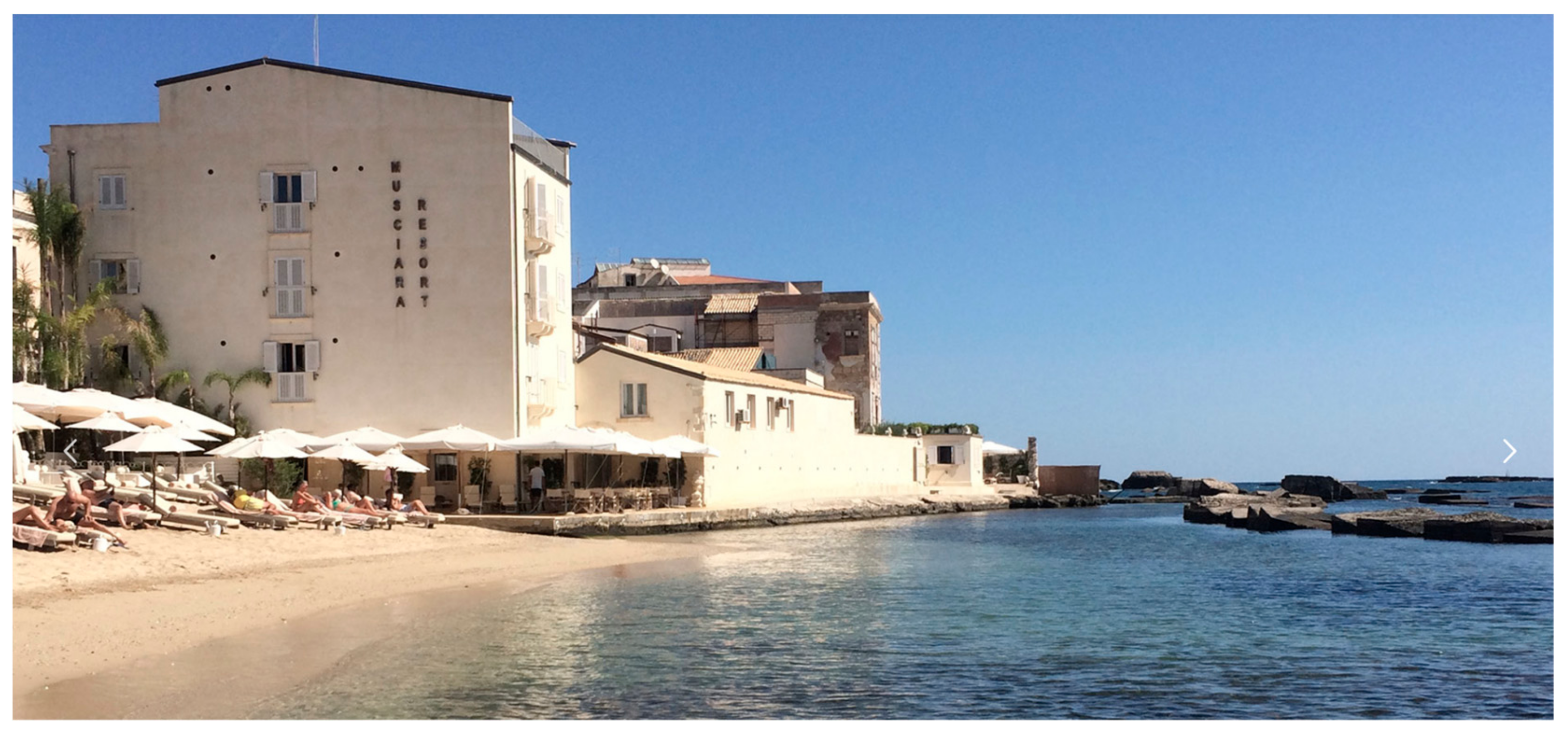
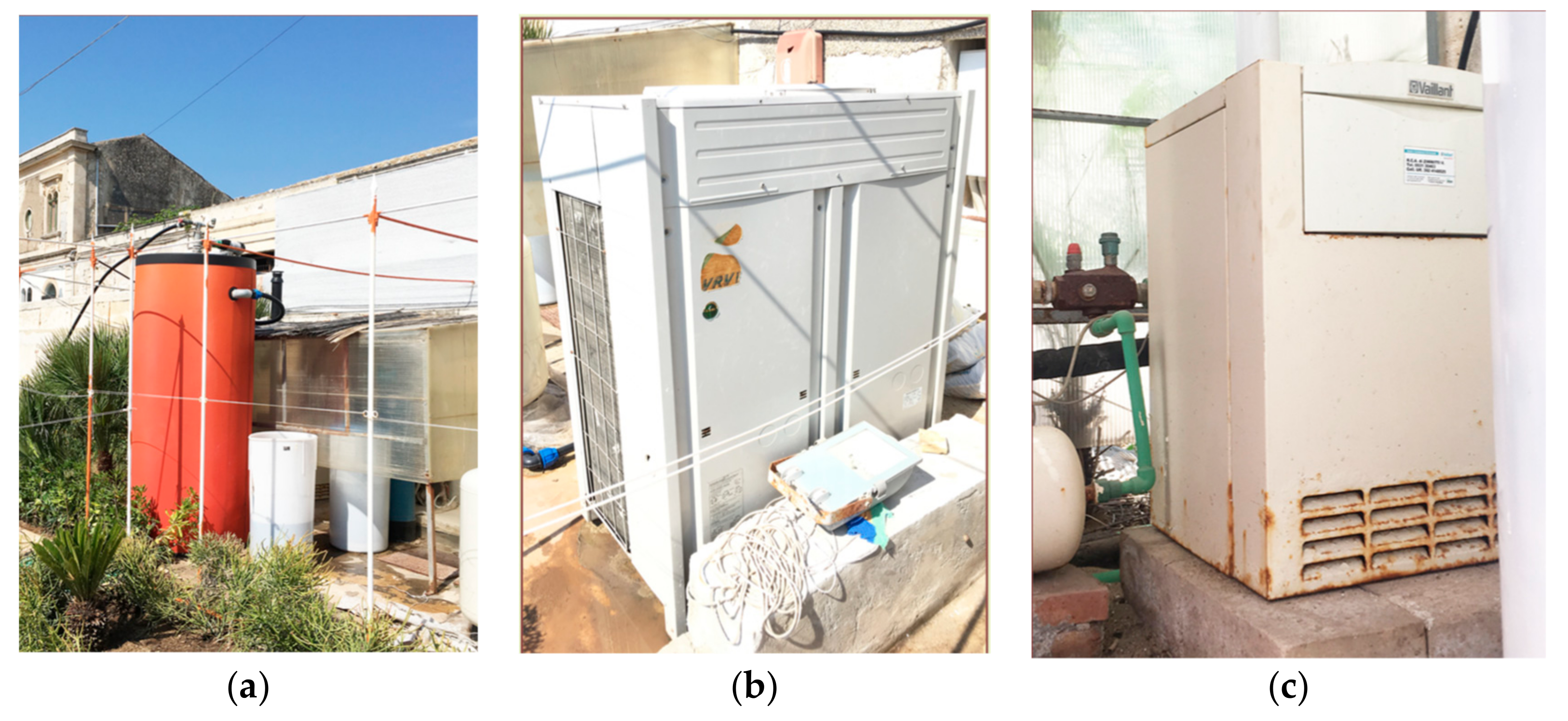
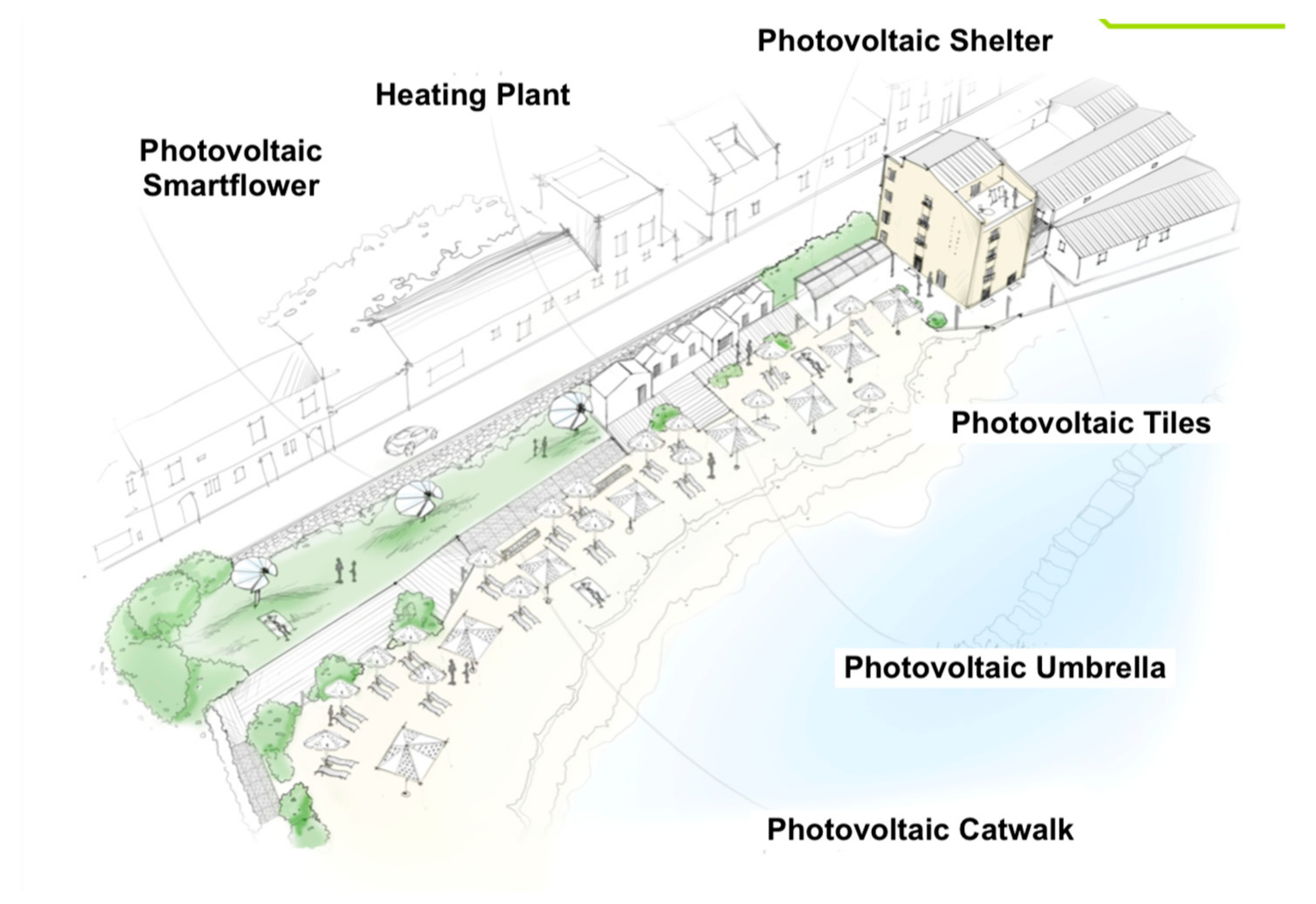
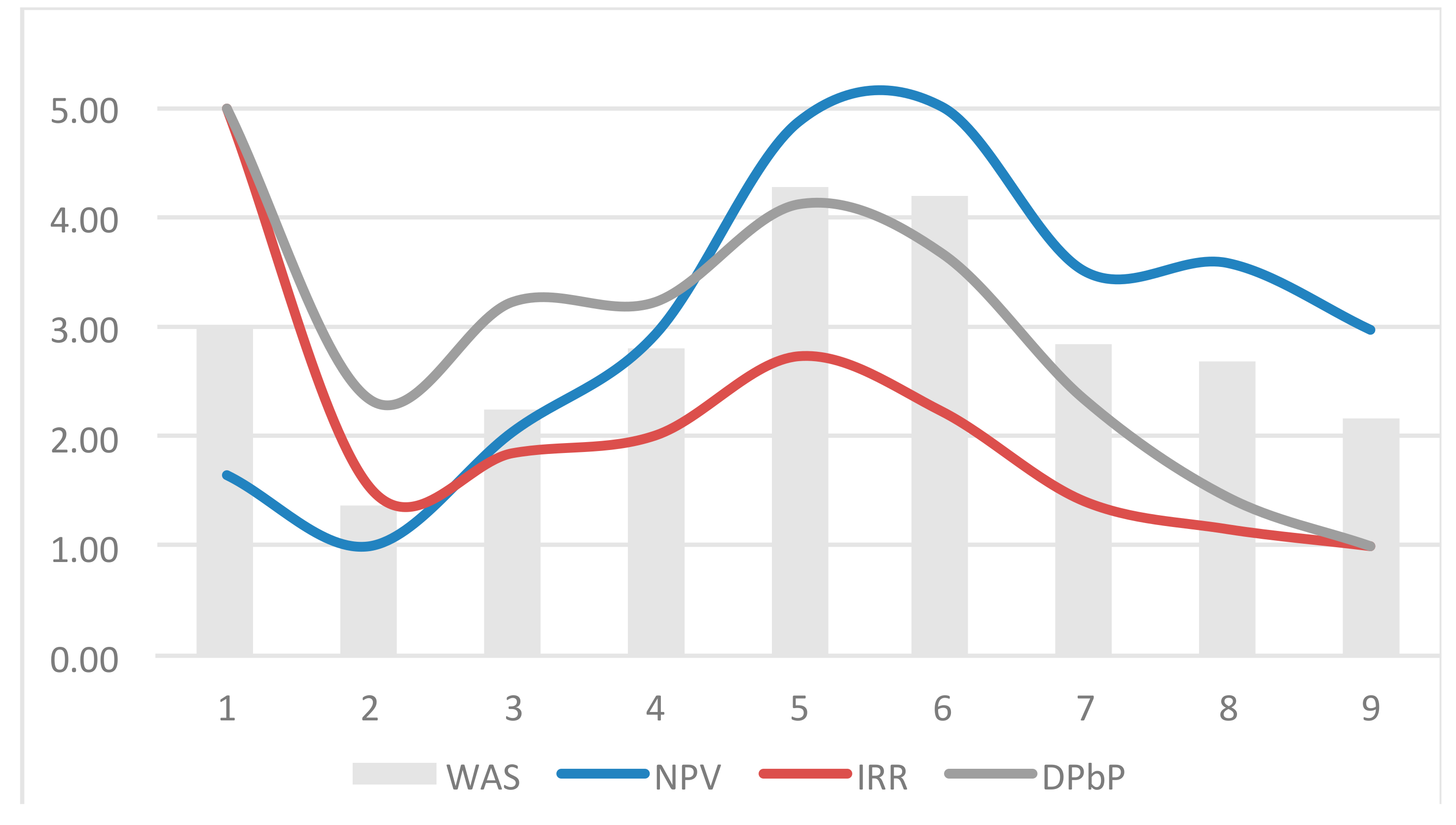
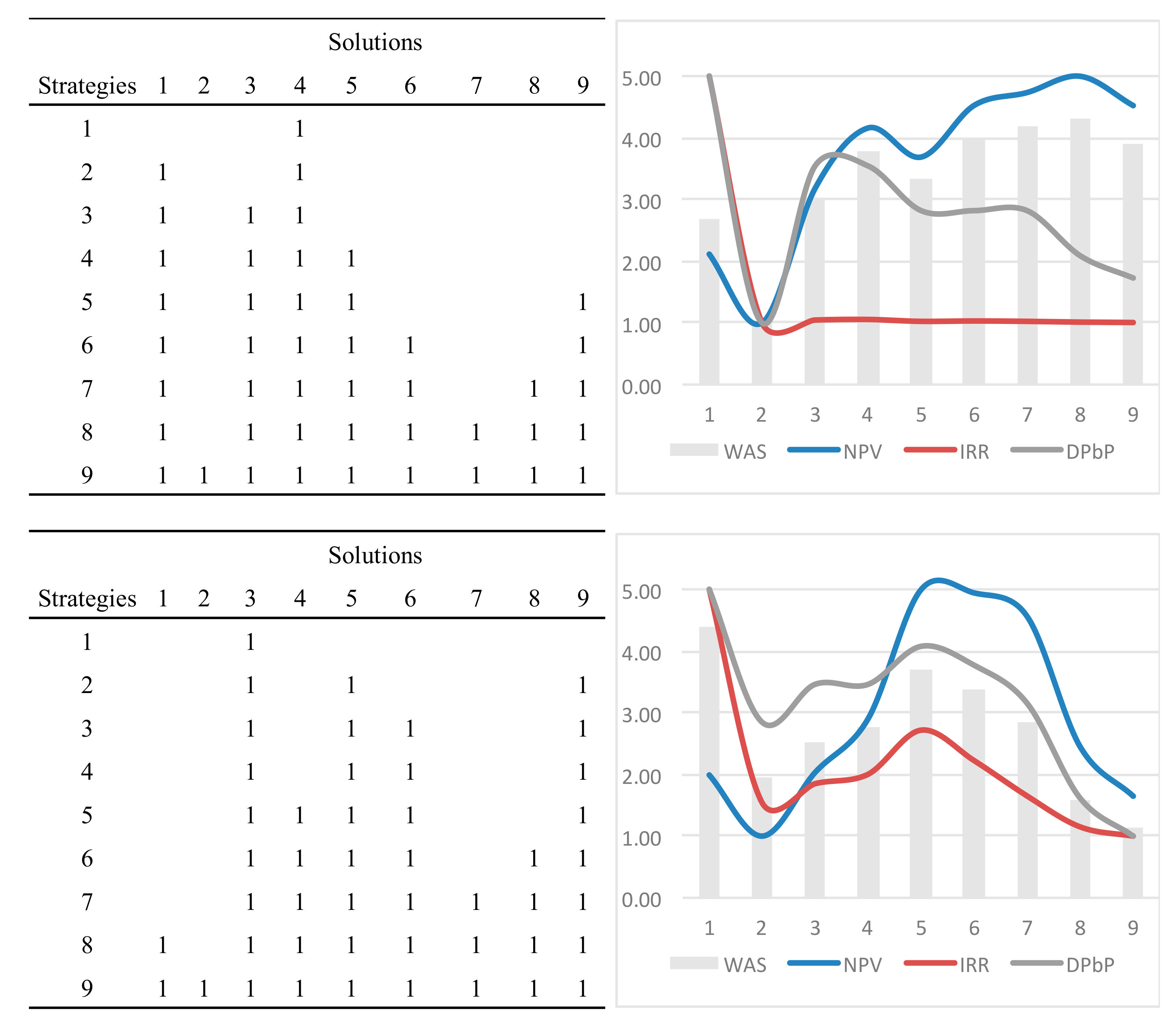
| Source | Real | Simulated | Variation |
|---|---|---|---|
| Natural Gas | 5910 Sm3 | 5138 Sm3 | 13.0% |
| 64.68 kWhth | 56.23 kWhth | ||
| 150 kWh·m−2·y−1 | 131 kWh·m−2·y−1 | ||
| Electricity | 48.45 kWh | 42.52 kWh | - |
| 113.0 kWh·m−2·y−1 | 99.0 kWh·m−2·y−1 |
| N | Energy Efficiency Measures | Proposed Solutions |
|---|---|---|
| 1 | Envelope Thermal Insulation (Internal) | Vacuum Insulation Panel |
| s = 10 mm; k = 0.005 W/m·K | ||
| 2 | Windows Replacement | Double Pane Wood Windows |
| U = 1.1 W/m2·K | ||
| 3 | Energy Systems Replacement | Water-To-Water Polyvalent HP for Space Heating, Cooling and DHW Heating Power = 21 kW; Cooling Power = 19 kW; COP = 4.52 |
| 4 | Light Bulbs Replacement | LED |
| 5 | Renewable Energy System | Photovoltaic Tiles; Area = 89.0 m2, P = 11.60 kWp |
| 6 | Photovoltaic Shelter; Area = 65.0 m2, P = 10.50 kWp | |
| 7 | Photovoltaic Smartflower; Number = 3, P = 6.93 kWp | |
| 8 | Photovoltaic Catwalk; Area = 158.0 m2, P = 9.50 kWp | |
| 9 | Photovoltaic Umbrella; Area = 330.0 m2, P = 19.80 kWp |
| B | 1 | 2 | 3 | 4 | 5 | 6 | 7 | 8 | 9 | |
|---|---|---|---|---|---|---|---|---|---|---|
| : EPgl,nr kW·m−2·y−1 | 311 | 303 | 296 | 130 | 220 | 239 | 248 | 270 | 254 | 195 |
| : EPgl,rin kW·m−2·y−1 | 97 | 54 | 87 | 126 | 62 | 102 | 101 | 95 | 99 | 114 |
| : CO2 Kg·m−2·y−1 | 65 | 64 | 62 | 29 | 45 | 49 | 51 | 56 | 52 | 39 |
| : Energy Class | C | B | B | A3 | C | A1 | A1 | B | B | A2 |
| Solutions | TOT | ||||||||||
|---|---|---|---|---|---|---|---|---|---|---|---|
| 1 | 2 | 3 | 4 | 5 | 6 | 7 | 8 | 9 | |||
| NPV | € | −44.2 | −17.9 | 69.4 | 57.1 | 30.7 | 26.1 | 2.2 | 4.1 | −19.3 | 108.1 |
| IRR | % | −31 | −31 | 31 | 684 | 15 | 13 | −10 | −8 | −17 | 9.2 |
| DPbP | y | - | - | 3 | 2 | 5 | 5 | 23 | 18 | - | 12 |
| Solutions | Weights | |||||||||
|---|---|---|---|---|---|---|---|---|---|---|
| 1 | 2 | 3 | 4 | 5 | 6 | 7 | 8 | 9 | ||
| EPgl,nr | 1.0 | 1.2 | 5.0 | 2.9 | 2.5 | 2.3 | 1.8 | 2.1 | 3.5 | 0.2 |
| EPgl,rin | 5.0 | 3.2 | 1.0 | 4.6 | 2.3 | 2.4 | 2.7 | 2.5 | 1.7 | 0.2 |
| CO2 | 1.0 | 1.2 | 5.0 | 3.2 | 2.7 | 2.5 | 1.9 | 2.4 | 3.9 | 0.3 |
| Class | 2.0 | 2.0 | 3.0 | 1.0 | 5.0 | 5.0 | 2.0 | 2.0 | 4.0 | 0.3 |
| 2.1 | 1.8 | 3.6 | 2.7 | 3.3 | 3.2 | 2.1 | 2.2 | 3.4 | - | |
| Ranking | 7 | 9 | 1 | 5 | 3 | 4 | 8 | 6 | 2 | - |
| NPV | 1.0 | 1.9 | 5.0 | 4.6 | 3.6 | 3.5 | 2.6 | 2.7 | 1.9 | - |
| IRR | 1.0 | 1.0 | 1.3 | 5.0 | 1.3 | 1.2 | 1.1 | 1.1 | 1.1 | - |
| DPbP | 1.0 | 1.0 | 4.8 | 5.0 | 4.5 | 4.5 | 1.3 | 2.2 | 1.0 | - |
| Strategies | Solutions | ||||||||
|---|---|---|---|---|---|---|---|---|---|
| 1 | 2 | 3 | 4 | 5 | 6 | 7 | 8 | 9 | |
| 1 | 1 | ||||||||
| 2 | 1 | 1 | |||||||
| 3 | 1 | 1 | 1 | ||||||
| 4 | 1 | 1 | 1 | 1 | |||||
| 5 | 1 | 1 | 1 | 1 | 1 | ||||
| 6 | 1 | 1 | 1 | 1 | 1 | 1 | |||
| 7 | 1 | 1 | 1 | 1 | 1 | 1 | 1 | ||
| 8 | 1 | 1 | 1 | 1 | 1 | 1 | 1 | 1 | |
| 9 | 1 | 1 | 1 | 1 | 1 | 1 | 1 | 1 | 1 |
| Strategies | Weights | |||||||||
|---|---|---|---|---|---|---|---|---|---|---|
| 1 | 2 | 3 | 4 | 5 | 6 | 7 | 8 | 9 | ||
| NPV | 69.4 | 50.1 | 80.8 | 106.9 | 164.0 | 168.1 | 123.9 | 126.1 | 108.1 | - |
| IRR | 36% | 13% | 15% | 16% | 21% | 17% | 12% | 10% | 9% | - |
| DPbP | 3.0 | 9.0 | 7.0 | 7.0 | 5.0 | 6.0 | 9.0 | 11.0 | 12.0 | - |
| NPV | 1.7 | 1.0 | 2.0 | 2.9 | 4.9 | 5.0 | 3.5 | 3.6 | 3.0 | 0.6 |
| IRR | 5.0 | 1.5 | 1.8 | 2.0 | 2.7 | 2.2 | 1.4 | 1.2 | 1.0 | 0.2 |
| DPbP | 5.0 | 2.3 | 3.2 | 3.2 | 4.1 | 3.7 | 2.3 | 1.4 | 1.0 | 0.2 |
| 3.0 | 1.4 | 2.2 | 2.8 | 4.3 | 4.2 | 2.8 | 2.7 | 2.2 | - | |
| Ranking | 3 | 9 | 7 | 5 | 1 | 2 | 4 | 6 | 8 | - |
| Technical–Environmental Profile | Economic–Financial Profile | |||||||
|---|---|---|---|---|---|---|---|---|
| Scenario | ||||||||
| 1 | 0.20 | 0.20 | 0.30 | 0.30 | 0.60 | 0.20 | 0.20 | 5% |
| 2 | 0.10 | 0.45 | 0.30 | 0.15 | 0.80 | 0.10 | 0.10 | 2% |
| 3 | 0.45 | 0.10 | 0.15 | 0.30 | 0.20 | 0.40 | 0.40 | 8% |
© 2019 by the authors. Licensee MDPI, Basel, Switzerland. This article is an open access article distributed under the terms and conditions of the Creative Commons Attribution (CC BY) license (http://creativecommons.org/licenses/by/4.0/).
Share and Cite
Nocera, F.; Giuffrida, S.; Trovato, M.R.; Gagliano, A. Energy and New Economic Approach for Nearly Zero Energy Hotels. Entropy 2019, 21, 639. https://doi.org/10.3390/e21070639
Nocera F, Giuffrida S, Trovato MR, Gagliano A. Energy and New Economic Approach for Nearly Zero Energy Hotels. Entropy. 2019; 21(7):639. https://doi.org/10.3390/e21070639
Chicago/Turabian StyleNocera, Francesco, Salvatore Giuffrida, Maria Rosa Trovato, and Antonio Gagliano. 2019. "Energy and New Economic Approach for Nearly Zero Energy Hotels" Entropy 21, no. 7: 639. https://doi.org/10.3390/e21070639
APA StyleNocera, F., Giuffrida, S., Trovato, M. R., & Gagliano, A. (2019). Energy and New Economic Approach for Nearly Zero Energy Hotels. Entropy, 21(7), 639. https://doi.org/10.3390/e21070639








